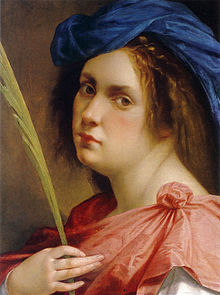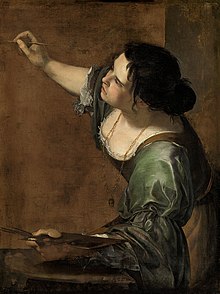Artemisia Gentileschi
Artemisia Gentileschi [ʤentileski] (* 8. July 1593 in Rome ; † after 31 January 1654 in Naples ) was an Italian painter of the Baroque . She is considered to be the most important painter of her era.
Life
Gentileschi was the daughter of the painter Orazio Gentileschi , who was then living in Rome, and the Prudentia Montone. Due to the death of her mother in 1605, she became a half-orphan . Artemisia often stood as a model for her father, who recognized her talent early on and taught her painting .
To learn the perspective, her father probably sent her to his fellow painter and friend Agostino Tassi , who raped Artemisia. With a promise of marriage (at that time it was socially impossible for a woman not to be married to a man with whom she had sexual contact) he extorted her silence, but he did not marry her - Tassi was probably already married. As a result, Orazio filed a lawsuit against Tassi in May 1612, during which Artemisia was tortured with a thumbscrew-like device to check her testimony and also subjected to a degrading gynecological examination to prove that she was not a prostitute . Tassi wanted to get out of the affair with this accusation; however, he was eventually sentenced to eight months in prison, including for stealing pictures. Despite Tassi's conviction and Artemisias immediately following marriage to the Florentine painter Pietro Antonio di Vicenzo Stiattesi, her good reputation could not be fully restored, which is why she moved to Florence . Her daughter Palmira was born there in 1620. Artemisia was given the honor of being the first woman to be accepted into the local Accademia dell'Arte del Disegno in 1616 . As early as 1615 she received her first major commission from Michelangelo Buonarroti the Younger , a great-nephew of Michelangelo .
Artemisia soon cultivated friendly relationships with painters, poets and other illustrious personalities, such as Cristofano Allori and Galileo Galilei . She became very well known and made a number of works for the Medici , with particular support from the Grand Duke of Tuscany , Cosimo II . In doing so, she also developed her own personal style, which no longer reminded of her father. Around 1620 she made her most famous picture Judith beheaded Holofernes . Tintoretto , Caravaggio , Casa Coppi and Adam Elsheimer also painted this motif . Judith interprets her version as a cold-blooded murderer and stands out due to the extremely realistic representation. Gentileschi dealt with the biblical story several times: The first two paintings were made as early as 1612/13, another around 1625.
In 1623 she was so famous that she was able to return to Rome with her two daughters, where she had several clients, including Cardinal Francesco Barberini , the nephew of Pope Urban VIII , and the Commendatore Cassiano dal Pozzo . In 1630 Artemisia went to Naples , which was then one of the most important cities in Europe and three times the size of Rome. She ran her own workshop there and received higher fees than her male colleagues. In 1635 she received an invitation to London to the court of King Charles I , where her father was now a court painter. However, she probably did not accept this invitation until 1637 and possibly supported the already sick father Orazio with the design of the ceiling painting in the Queen's House in Greenwich . The following year her father died in England.
She returned to Naples and was particularly encouraged by the patron Don Antonio Ruffo of Messina. At this point, the style of her painting also changed. The last years of her life were marked by health and financial difficulties. Letters from 1648 to 1650 to their client Ruffo prove their burdens. She died in Naples around 1652/53.
plant
Artemisia Gentileschi was strongly influenced, especially in her early work, by her father, who was also her teacher, and adopted his love for precision in details and baroque pathos . Like her father, she was strongly influenced by Adam Elsheimer and Caravaggio , both of whom were personally acquainted with the Gentileschi. Orazio and Artemisia Gentileschi can be regarded as important representatives of the painting style Caravaggism , named after Caravaggio , which impressed with its realistic representation and dramatic lighting effects.
When she was married in 1612 and moved to Florence, she further developed her painting style and broke away from that of her father. Her pictures became even more lively and emotional. She also developed Caravaggism further by making the colors shine even brighter and brighter. Their characteristic colors are brown and ocher tones, bright red and strong blue as well as shades in orange tones. Typical of them are also precisely painted folds and the high materiality of the clothes.
However, both daughter and father were able to adapt their style to the respective artistic landscapes in which they were active. And just as Orazio adapted to the taste of the English court in his late work in England, Artemisia adopted a Florentine style of painting in Florence and a Neapolitan style in Naples. In her late work, she also changed her conception of femininity and approached the Bolognese painting style, which again demanded the idealized exaggeration of the human being. Their figures became more delicate, the female figures lost activity and strength.
It is known that in later times she studied nude models for her compositions, but in many of her pictures her own facial features and body shapes appear, for example in the self-portrait as an allegory of painting .
It is unusual that Artemisia was active in a professional field that was particularly dominated by men at the time and had her own workshop with male employees. Furthermore, unlike the few other female painters of her time known by name, she did not limit herself to genres typical of women at the time - such as portrait painting , flower and fruit still life , miniature painting , landscape painting - but chose what was regarded as the finest genre of painting at the time and history painting, usually reserved for male painters, as well as mythological and biblical subjects, which she implemented in large formats. The protagonists of her pictures are often female heroines, for example Judith or Lucretia .
Artemisia's pictures show women of unusual charisma, whose poses express psychological rather than physical drama. Your female characters are courageous, determined, energetic and show above all the feelings of fear, powerlessness and distress.
reception
Although she was very famous during her lifetime, she was forgotten after her death. It wasn't until the 1960s - in the wake of feminist movements - that people became aware of them again.
The feminist artist Judy Chicago dedicated one of the 39 place settings at the table to her in her work The Dinner Party .
“Two more women painters should be mentioned, who did honor to the fatherland. One was Marietta Robusti , the daughter of Tintoretto […] Artemisia Gentileschi was born in the year she died. She developed under the direction of Guidi Reni and achieved great fame during her life, especially for her excellent portraits. She lived in Naples, then in England, where she also died and left valuable works. But there are also paintings of her in the Pitti Palace and in the Museum of Naples . In this museum - significant enough - a room is adorned with four classic paintings by four different painters: by Artemisia Gentileschi, Elisabetta Sirani , Sofonisba Anguissola and Lavinia Fontana . "
Catalog of works (selection)
The paintings by Artemisia Gentileschi were cataloged by Raymond Ward Bissell in 1999 under the title Artemisia Gentileschi and the Authority of Art: Critical Reading and Catalog Raisonné . The 50 or so works of art have since been provided with catalog numbers [WB ...]. Paintings that no longer exist are marked with the prefix "L-". Paintings that are not clearly created by Artemisia are marked with the prefix "X-".
| WB | image | title | year | Size / material | Exhibition / collection / owner | Remarks |
|---|---|---|---|---|---|---|
| 1 |  |
Madonna and Child | 1609-1610 |
118 × 86 cm, oil on canvas |
Florence , Palazzo Pitti , Galleria Palatina | |
| 2 | 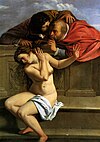 |
Susanna and the elders | 1610 |
170 × 121 cm, oil on canvas |
Pommersfelden , Weißenstein Castle , Schönborn art collection | |
| 3 |  |
Lucretia | around 1611 |
54 × 51 cm, oil on canvas |
Genoa , Palazzo Cattaneo-Adorno | |
| 4th |  |
Judith beheads Holofernes | around 1612 |
162 × 126 cm, oil on canvas |
Naples , Museo di Capodimonte | |
| 5 | 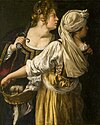 |
Judith with her maid | 1612-1614 |
114 × 93.5 cm, oil on canvas |
Florence , Palazzo Pitti , Galleria Palatina | |
| 6th |  |
Saint Catherine of Alexandria | around 1614-1615 |
77 × 63 cm, oil on canvas |
Florence , Uffizi Gallery | |
| X-6 |  |
Cleopatra | around 1611-1612 |
118 × 181 cm, oil on canvas |
Milan , Amedeo Morandotti collection | possibly painted by or with Orazio Gentileschi |
| 7th | 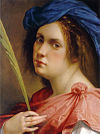 |
(Self-portrait as) martyr | around 1615 |
32 × 24.5 cm, oil on panel |
New York , Newhouse Galleries | |
| X-7 |  |
Danae | around 1611-1612 |
41.3 × 52.7 cm, oil on copper |
St. Louis , The Saint Louis Art Museum | possibly painted by Orazio Gentileschi |
| 8th |  |
The natural talent | around 1615-1616 |
152 × 61 cm, oil on canvas |
Florence , Casa Buonarroti | |
| 9 |  |
The repentant Magdalena | around 1615-1616 |
65.7 × 50.8 cm, oil on canvas |
Los Angeles , Marc A. Seidner Collection | |
| 10 |  |
Conversion of Magdalena ( Repentant Magdalena ) |
around 1617-1620 |
146.5 × 108 cm, oil on canvas |
Florence , Palazzo Pitti , Galleria Palatina | |
| 11 |  |
Jaël and Sisera | 1620 |
86 × 125 cm, oil on canvas |
Budapest , Szépművészeti Múzeum | |
| X-11 |  |
Joseph and the wife of Potiphar | around 1622–1623 |
231.8 × 194.9 cm, oil on canvas |
Cambridge , Massachusetts , Fogg Art Museum | possibly painted by Paolo Finoglia |
| 12 | 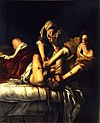 |
Judith and Holofernes | 1614-1620 |
199 × 162.5 cm, oil on canvas |
Florence , Uffizi Gallery | |
| 13 |  |
Portrait of a Gonfaloniere | 1622 |
208 × 128 cm, oil on canvas |
Bologna , Palazzo D'Accursio, Collezioni Comunali d'Arte | |
| 14th |  |
Judith with her maid | around 1623-1625 |
184 × 141.6 cm, oil on canvas |
Detroit , Institute of Arts | |
| L-14 | Christ blesses the children | lost | ||||
| 15th |  |
Aurora | around 1625–1627 |
218 × 146 cm, oil on canvas |
Rome , private property | |
| 16 |  |
The repentant Magdalena | around 1621-1622 |
122 × 96 cm, oil on canvas |
Seville , cathedral | |
| 17th |  |
The repentant Magdalena | around 1621-1622 |
136.5 × 100 cm, oil on canvas |
Mexico City , Museo Soumaya | |
| L-17 | Cupid and Psyche | around 1624 | lost | |||
| X-17 |  |
Lucretia | 1642-1643 |
206 × 182 cm, oil on canvas |
Naples , Palazzo Reale | |
| 18th |  |
Venus and Cupid ( Sleeping Venus ) | around 1625–1627 |
94 × 144 cm, oil on canvas |
Richmond , Virginia Museum of Fine Arts | |
| X-19 |  |
Madonna and Child | around 1610 |
116.5 × 86.5 cm, oil on canvas |
Rome , Palazzo Spada | |
| L-20 | David with his harp | lost | ||||
| 21st |  |
The repentant Magdalena | around 1627-1629 |
100 × 73 cm, oil on canvas |
Sorrento , Museo Correale di Terranova | |
| 22nd |  |
Cleopatra | around 1627-1629 |
117 × 175.5 cm, oil on canvas |
Rome , private property | |
| L-22 | David with the head of Goliath | 1631 | lost | |||
| 24 |  |
Annunciation to Mary | 1630 |
257 × 179 cm, oil on canvas |
Naples , Museo di Capodimonte | |
| X-25 |  |
Saint Catherine of Alexandria | around 1620 | Oil on canvas | El Paso , Texas , Museum of Art, The Kress Collection | painted with Orazio Gentileschi |
| 27 | 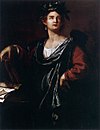 |
Klio, Muse of History ( The Glory ) | 1632 |
127.6 × 97.2 cm, oil on canvas |
New York , privately owned | |
| L-27 | Diana in the bath with Aktaion | around 1649-1650 | lost | |||
| 28 |  |
Esther before Ashaver | around 1630 |
208.3 × 273.7 cm, oil on canvas |
New York , Metropolitan Museum of Art | |
| X-28 | 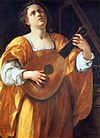 |
Lute player / Saint Cecilia | around 1610-1612 |
108 × 78.5 cm, oil on canvas |
Rome , Palazzo Spada | |
| 30th |  |
Corisca and the satyr | around 1633-1635 |
155 × 210 cm, oil on canvas |
Naples , private property | |
| 31 | Venus in an embrace with Cupid | around 1634 |
121 × 160 cm, oil on canvas |
Kreuzlingen , Heinz Kisters collection | ||
| 32 |  |
The birth of John the Baptist | 1635 |
184 × 258 cm, oil on canvas |
Madrid , Prado | |
| 33a |  |
Saint Proculus and his mother Nicea | around 1635 |
300 × 180 cm, oil on canvas |
Naples , Museo Nazionale di San Martino | |
| 33b |  |
St. Januarius with his companions in the amphitheater | around 1635 |
308 × 200 cm, oil on canvas |
Naples , Museo Nazionale di San Martino | |
| 33c | 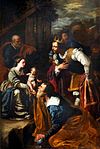 |
Adoration of the Magi | around 1635 |
308 × 205 cm, oil on canvas |
Naples , Museo Nazionale di San Martino | |
| 35 |  |
Samson and Delilah |
around 1635 (original), around 1640 (copy) |
Oil on canvas | Naples , Museo di Capodimonte , Collection of the Banco di Napoli (copy) | |
| 36 |  |
Minerva ( Sapienza ) | around 1615 |
131 × 103 cm, oil on canvas |
Florence , Procura Generale della Repubblica | |
| 37 |  |
Bathsheba in the bath | around 1636 |
265 × 210 cm, oil on canvas |
Columbus , Ohio , Museum of Art | painted together with other artists |
| 39 | 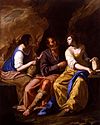 |
Lot and his daughters | around 1636–1637 |
230.5 × 183 cm, oil on canvas |
Toledo , Ohio , Museum of Art | |
| L-39 | Hercules | 1620 | lost | |||
| 40 |  |
Bathsheba in the bath | around 1637-1638 |
204.5 × 155.5 cm, oil on canvas |
Halle , private property | |
| 41 | 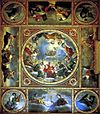 |
Allegory of Peace and the Arts under the Rule of the English King | 1636-1639 |
892 × 1070 cm, oil on canvas |
London , Marlborough House | Ceiling painting, painted together with Orazio Gentileschi |
| 42 |  |
Allegory of Painting Self-Portrait as La Pittura |
around 1638–1639 |
96.5 × 73.7 cm, oil on canvas |
London , Kensington Palace , The Royal Collection | |
| X-42 |  |
Susanna and the elders | 1622 |
161.5 × 123 cm, oil on canvas |
Stamford , England , The Burghley House Collection | possibly not painted by Artemisia |
| 45 |  |
Bathsheba in the bath | around 1640 |
225 × 226 cm, oil on canvas |
Vienna , Alexander Haas Collection | |
| 46 |  |
Bathsheba in the bath | around 1640-1645 |
288 × 228 cm, oil on canvas |
Rome , private property | |
| 47 |  |
Judith and her maid | around 1640-1645 |
235 × 172 cm, oil on canvas |
Cannes , Musee de la Castre | |
| 48a |  |
Bathsheba in the bath | around 1645-1650 |
258 × 218 cm, oil on canvas |
Potsdam , New Palace , Upper Gallery | |
| 48b | 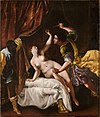 |
Tarquinius and Lucretia | around 1645-1650 |
261 × 226 cm, oil on canvas |
Potsdam , New Palace , Upper Gallery | |
| 48c |  |
Judith and her maid Abra with the head of Holofernes | around 1645-1650 |
272 × 221 cm, oil on canvas |
Naples , Museo di Capodimonte | |
| 49 |  |
The triumph of Galatea | around 1650 |
152.1 × 205.1 cm, oil on canvas |
New York , Washington , National Art Gallery | probably painted together with Bernardo Cavallino |
| 50 |  |
Susanna and the two old people | 1649 |
205 × 168 cm, oil on canvas |
Brno , Moravská galerie v Brně | |
| 51 | 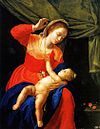 |
Madonna and Child (with rosary) | 1650-1651 |
59.5 × 38.5 cm, oil on copper, mounted on wood |
El Escorial , Museo de Pintura | |
| L-53 | Bathsheba in the bath | around 1650–1652 |
269 × 222 cm, oil on canvas |
Destroyed in 1940 | ||
| L-75 | John the Baptist | lost | ||||
| L-104 | Susanna and the two old people | 1652 | 263 × 233 cm | lost | ||
| without WB |  |
Self-portrait as a lute player | around 1615-1617 |
65.5 × 50.2 cm, oil on canvas |
Hartford , Wadsworth Atheneum | possibly not painted by Artemisia |
literature
- Debra N. Mancoff: Women who changed art Prestel Munich 2012, ISBN 978-3-7913-4732-5 , pp. 8-10, 107-109.
- Christiane Weidemann, Petra Larass, Melanie Klier: 50 women artists you should know. Prestel Munich 2008, ISBN 978-3-7913-3957-3 , pp. 22-25.
- Christina Haberlik, Ira Diana Mazzoni : 50 classics - artists, painters, sculptors and photographers . Gerstenberg, Hildesheim 2002, ISBN 978-3-8067-2532-2 , pp. 23-29.
- Keith Christiansen: Becoming Artemisia: Afterthoughts on the Gentileschi Exhibition. In: Metropolitan Museum Journal. 39, 2004, ISSN 0077-8958 , pp. 101-126.
- Yvonne Dudziak-Kloe: Artemisia Gentileschis - Susanna in the bath. A picture investigation, library Schloß Weissenstein Pommersfelden catalog, 2005.
- Mary D. Garrard : Artemisia Gentileschi. The Image of the Female Hero in Italian Baroque Art. Princeton University Press, Princeton NJ 1991, ISBN 0-691-04050-8 .
- Mary D. Garrard: Artemisia Gentileschi around 1622. The shaping and reshaping of an artistic identity. University of California Press, Berkeley CA et al. a. 2001, ISBN 0-520-22426-4 . ( California Studies in the History of Art. Discovery Series 11)
- Nadja Henle: The emancipated self-portrait. Music and eroticism in the works of Artemisia Gentileschi. VDM Verlag, Saarbrücken 2009, ISBN 978-3-639-12279-4 .
- Judith W. Mann (Ed.): Artemisia Gentileschi. Taking stock. Brepols, Turnhout 2005, ISBN 2-503-51507-X .
- Susanna Stolzenwald: Artemisia Gentileschi. Bonding and liberation in the life and work of a painter. Belser, Stuttgart et al. 1991, ISBN 3-7630-2073-X .
- Dagmar Lutz: Artemisia Gentileschi: Life and Work . Belser, Stuttgart 2011, ISBN 978-3-7630-2586-2 .
- Susan Vreeland: The Passion of Artemisia. Viking, New York NY 2002, ISBN 0-670-89449-4 .
- German: The painter. Diana-Verlag, Munich a. a. 2002, ISBN 3-8284-0063-9 .
- R. Ward Bissell: Artemisia Gentileschi and the Authority of Art. Critical Reading and Catalog Raisonne . Pennsylvania State University Press, 1999, ISBN 0-271-01787-2 .
- Christine Tauber: Judith, do your part. Act of revenge of the victim? Rational act of the heroine - and the painter: The supposed trauma of Artemisia Gentileschi as an example of feminist misinterpretation. In: Frankfurter Allgemeine Zeitung , Geisteswissenschaften, No. 195, Wednesday, August 23, 2017, p. N3.
- Christa Wachenfeld (ed.): The rape of Artemisia . The process. With an essay by Roland Barthes. Translated from the Latin / Italian sources Gertraude Grassi. Freiburg (Breisgau): Kore, 1992. ISBN 3-926023-34-1 .
- Susanna Partsch : Gentileschi, Artemisia . In: General Artist Lexicon . The visual artists of all times and peoples (AKL). Volume 51, Saur, Munich a. a. 2006, ISBN 3-598-22791-4 , pp. 402-406.
Film adaptations
- Artemisia . Direction: Agnès Merlet , France / Italy / Germany, 1997, with Valentina Cervi as Artemisia
Trivia
- The Prix Artemisia for comics and graphic novels has been awarded in France since 2008 . It is awarded once a year to an outstanding work by an artist.
- On July 8, 2020, Artemisia Gentileschi was honored by the search engine Google with a doodle for her 427th birthday.
Web links
- Literature by and about Artemisia Gentileschi in the catalog of the German National Library
- The Life and Art of Artemisia Gentileschi (English)
- Artemisia Gentileschi at ArtCyclopedia (English)
- Prix Artemisia (French)
Individual evidence
- ↑ [1]
- ↑ a b c d Volker Barth: Artemisia Gentileschi . In: PM History . January 2005, p. 81.
- ↑ Brooklyn Museum page on the artwork, accessed April 15, 2014.
- ↑ IB Münz: Important female artists from the XV. and XVI. Century . In: Wiener Hausfrauen-Zeitung . No. 46 , 1902, pp. 412 ( ANNO - AustriaN Newspapers Online [accessed July 22, 2020]).
- ^ Artemisia Gentileschi: An artistic Google doodle for the 427th birthday of the Italian baroque painter - GWB. In: GoogleWatchBlog. July 8, 2020, accessed on July 8, 2020 (German).
| personal data | |
|---|---|
| SURNAME | Gentileschi, Artemisia |
| ALTERNATIVE NAMES | Lomi, Artemisia |
| BRIEF DESCRIPTION | Italian Baroque painter |
| DATE OF BIRTH | July 8, 1593 |
| PLACE OF BIRTH | Rome |
| DATE OF DEATH | around 1653 |
| Place of death | Naples |
